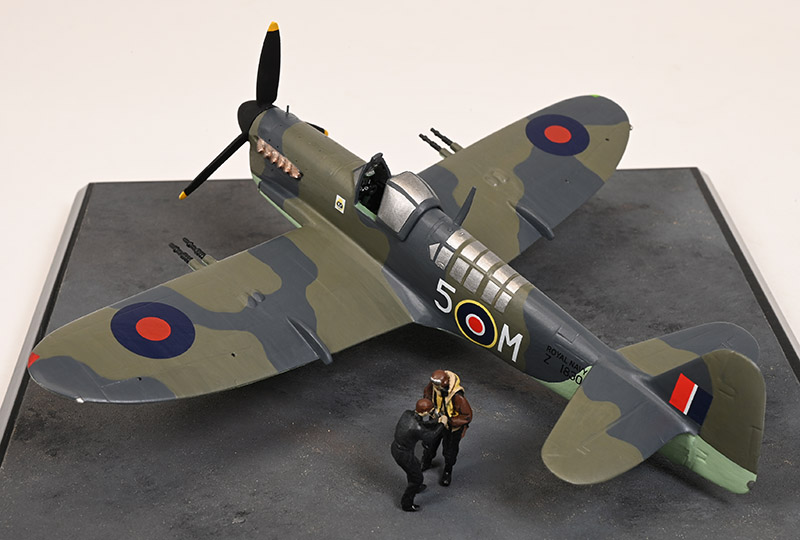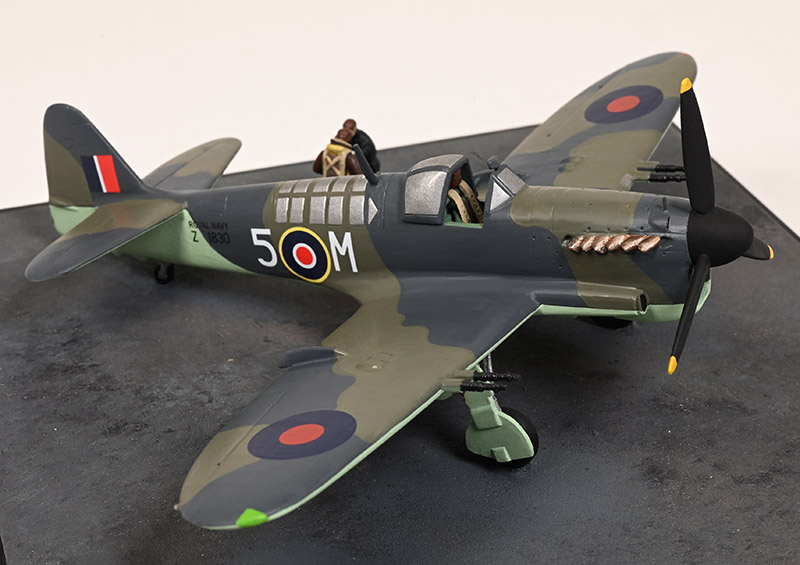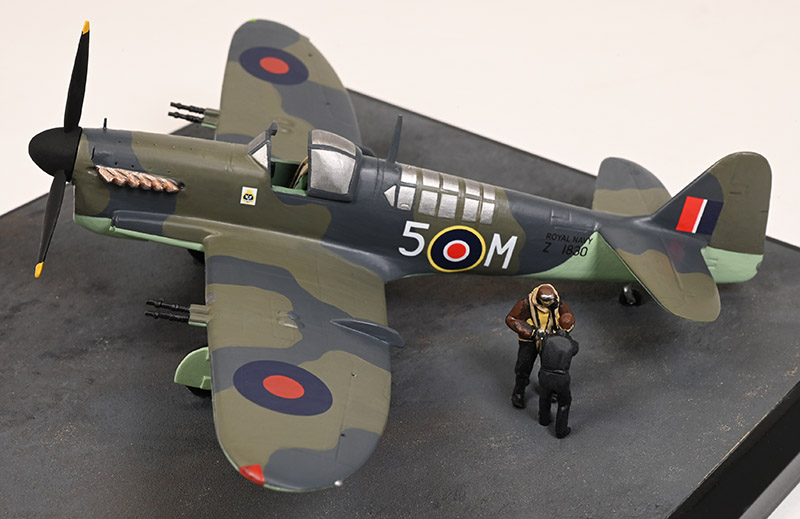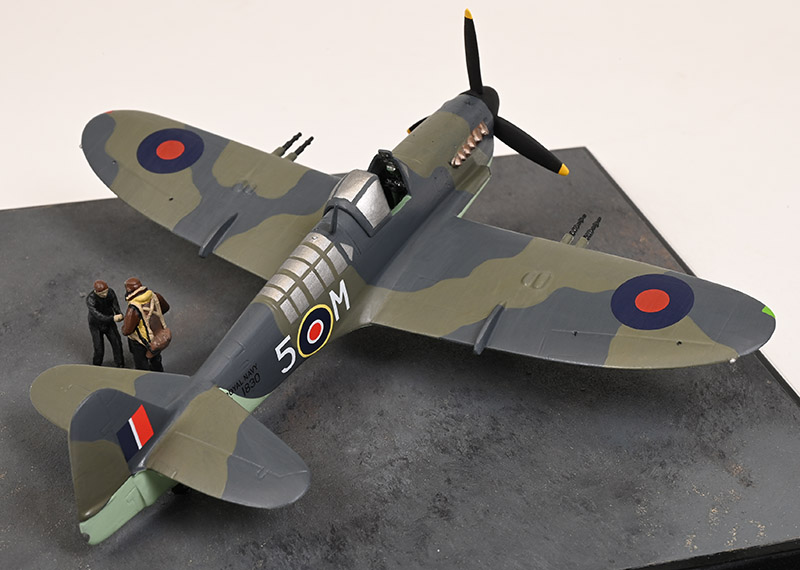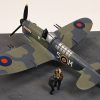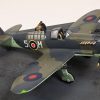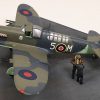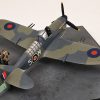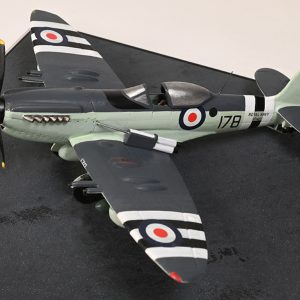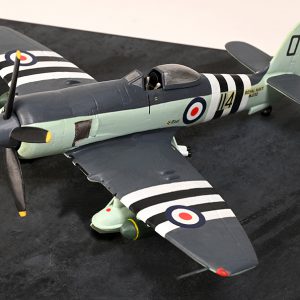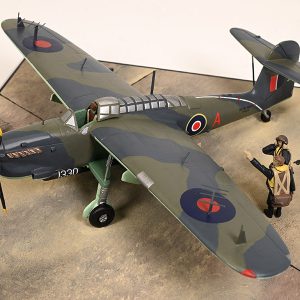Fairey Firefly F Mk I
Z1830 5-M 1770 Naval Air Squadron,
HMS Indefatigable, Operation Mascot, July 1944.
The origins of the Fairey Firefly monoplane were in Specifications N.8/39 and N.9/39 (a turreted version), issued at a time when the Admiralty had regained control of Royal Naval aviation. Fairey’s design was submitted in September 1939, and an order was placed with Faireys at Hayes for an initial 200 Firefly F.Mk.I aircraft in June 1940. This fulfilled Specification N.5/40 for a multi-purpose aircraft with strong fighter capabilities; it was powered by a Rolls-Royce Griffon engine of 1,730 hp. and armed with four 20 mm cannon, giving it a marked performance and weapons advantage over the Fulmar it replaced, and its distinctive fully-retractable Fairey-Youngman flaps contributed to the good low-speed performance necessary for carrier operations.
The first prototype Fairey Firefly Z1826 was flown from the Great West aerodrome by Chris Staniland on 22 December 1941, with the shallower front canopy that was identified the early Mark Is; Z1828 carried out deck-landing trials on HMS Illustrious toward the end of 1942, and the first production Fairey Firefly I Z1830 flew in January 1943 and was delivered to the Navy on 4 March. During production of the Fairey Firefly Mark I – 872 in total, by the end of 1946 – a higher front canopy for improved pilot visibility became standard, and more powerful engines were introduced with the Griffon XII of 1990 hp. Other variants such as the Firefly FR.Mk.I and the Firefly NF.Mk.I were recognisable by their anti-shipping or anti-aircraft radar pods fitted below the engine cowling.
The Navy started a new numerical unit sequence when 1770 Naval Air Squadron was commissioned with Fireflies at Yeovilton on 10 September 1943 with 12 Fairey Firefly F.Mk.Is, working up in Scotland before joining HMS Indefatigable in May 1944. On 17 July 1944, the squadron took part in Operation Mascot conducted against the German battleship Tirpitz at her anchorage in Kaafjord, Norway. The attack was the second of a series of strikes against the battleship launched from aircraft carriers between April and August 1944. Admiral Moore commanded the operation from his flag ship HMS Duke of York. Strike aircraft flew from HMS Formidable, HMS Indefatigable and HMS Furious and the force employed 44 Fairey Barracuda dive bombers and 48 fighters (18 Vought Corsairs, 18 Grumman Hellcats and 12 Fairey Fireflys, including Z1830, 5-M). In the early hours of 17 July, German radar stations detected the attackers while they were en route to Kaafjord, and Tirpitz was protected by a smoke screen by the time the strike force arrived. As a further defence, the Germans had installed a mountaintop observation post on the crest of the high ground on the north-western side of the fjord, and it had a direct communications link to the battleship. Not only did this serve as a lookout, reporting on the course, number and height of the approaching planes, but the post also contained a flak direction team. Using new airburst shells, the Tirpitz was able to add the weight of her main and secondary guns to the flak barrage. While of limited use save as a deterrent, these larger shells added greatly to the strength of the flak barrage thrown up from the battleship by her dedicated 10.5cm flak guns. In addition her 3.7cm and 20mm guns were sending up streams of tracer, as were the flak batteries lining the fjord. It was into this maelstrom of smoke and fire that the strike aircraft began their attack, at around 0234hrs. It was the navy fighters who led the way, with 1770 squadron’s Fireflies swooping down into the fjord to strafe the battleship and any flak batteries they spotted on the shore. Few of the airmen in the bomber force were able to spot the battleship, and their attacks did not inflict any significant damage. Admiral Moore planned to repeat the attack the following morning at 0800hrs. The strike aircraft were actually ranged on deck for this second attack, when the appearance of fog, both around the carriers and in the target area, led to the attack being cancelled. German losses were limited to a patrol craft, and three British aircraft were destroyed or damaged beyond repair by Kaafjord’s defenders. A group of German submarines attempted to intercept the carrier force as it returned to base, without success. Two U-boats were sunk near the carriers by patrol aircraft and several others were damaged.
The Fairey Firefly went through two distinct stages of further modification and development; the Mark IV had a much more streamlined nose housing its Griffon 74 of 2,100 hp., with radiators transferred to the wing roots, clipped wing tips and a revised vertical tail. The same airframe served for the AS.5 and AS.6 anti-submarine variants, and it was this version that saw service in the Korean conflict. Pilot training versions of both the I and the IV were produced with a raised second cockpit for the instructor taking the place of the observers’ station. The type’s third iteration had a semi-annular chin radiator intake, a larger “squared-off” vertical tail and a big “bubble” transparency replacing the framing over the Observers’ position. Originally intended as an anti-submarine aircraft, the Mk.7’s principal use was for training, and the U.8s were target drones. Many T.7s were also modified as U.9 drones.


